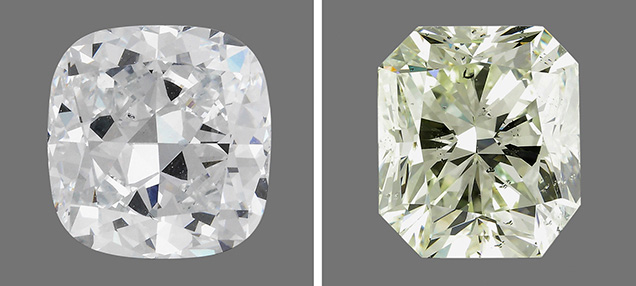Large HPHT-Grown Synthetic Diamonds Examined in GIA’s Hong Kong Laboratory

The first was a 4.30 ct cushion shape with D color and a clarity grade of SI1, based on three small clusters of metallic inclusions. The other was a 5.11 ct cut-cornered rectangular modified brilliant. It had K color and a clarity grade of I1, the result of a few metallic inclusions and two small fractures in the girdle area. Neither one showed reaction to long-wave UV radiation. When they were exposed to short-wave UV, a medium to strong green-yellow fluorescence was observed. Both showed strong yellow-green phosphorescence lasting more than 20 seconds. One noteworthy feature was the absence of pinpoint inclusions, which are common in HPHT synthetic diamonds and often distributed throughout the crystal.
Absorption spectra in the infrared region demonstrated these were type II diamonds, with no absorption band detected in the one-phonon region (approximately 1350–1000 cm–1) where nitrogen impurities occur. A very weak 2800 cm–1 band was attributed to trace substitutional boron. A higher boron concentration was recorded in the D-color synthetic diamond (7 ± 1 ppb, compared to 1.2 ± 0.2 ppb). Photoluminescence spectra collected at liquid-nitrogen temperature with varying laser excitations revealed an emission doublet at 736.6/736.9 nm from the silicon-vacancy defect, and an 882.7/884.4 nm doublet from the well-known Ni-related defect. Very weak emissions from nitrogen-vacancy centers at 575.0 and 637.0 nm were detected only in the K-color sample. Besides metallic inclusions, another important identification feature of HPHT synthetics is fluorescence. Typical fluorescence patterns showing multiple-sector growth were observed in both samples.
These two diamonds were disclosed as HPHT synthetic when submitted for examination. Tested using the GIA DiamondCheck device, both were referred for further testing. Gemological observations and spectroscopic features confirmed they were HPHT synthetics.
Examination of these improved HPHT synthetic diamonds, the largest synthetic diamonds produced by any method that GIA has examined so far, demonstrated significant progress in this growth technology. In addition to their use as gem materials, crystals of this size have many potential industrial applications.



